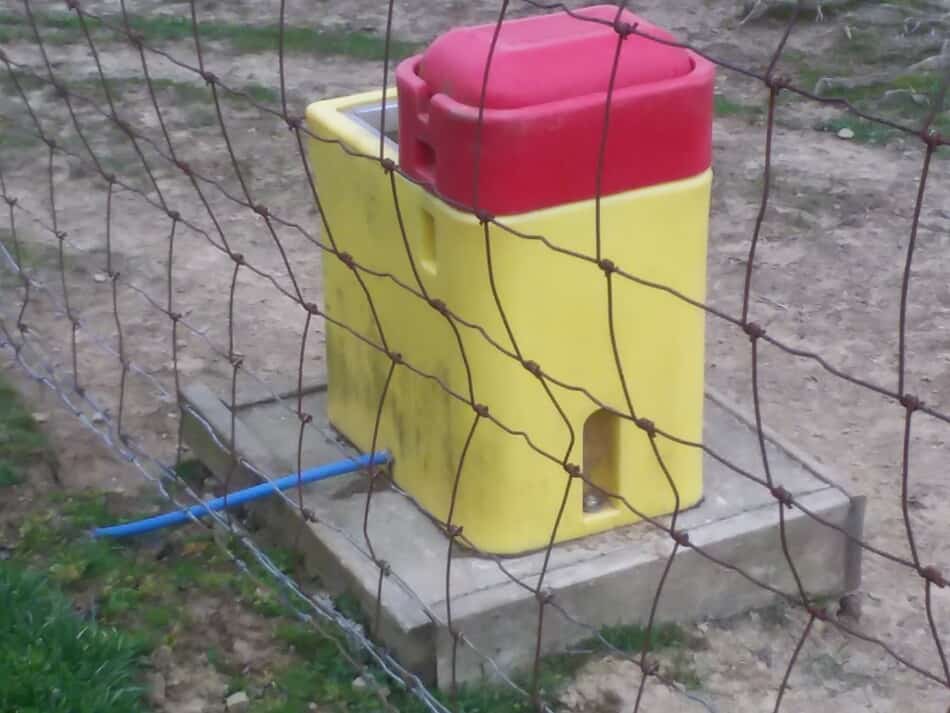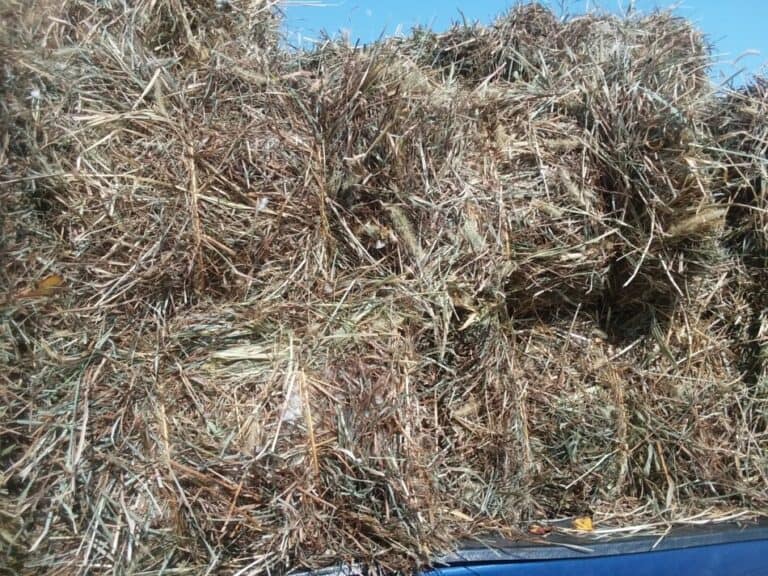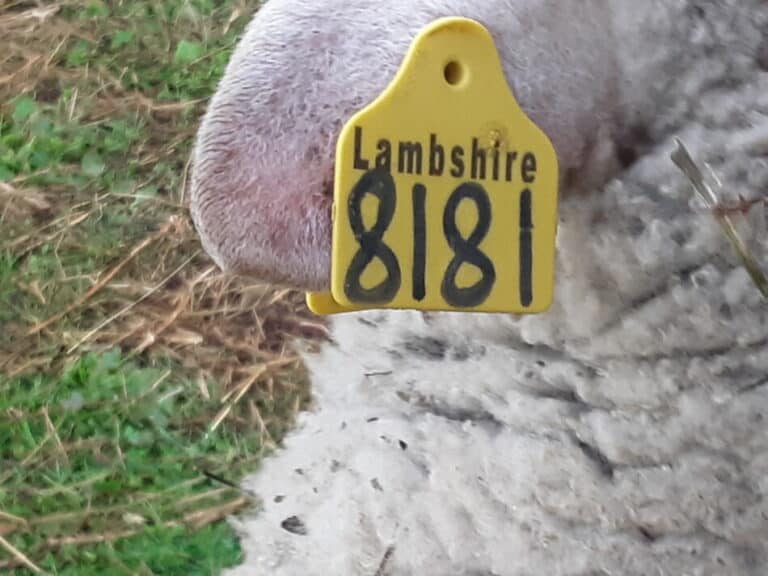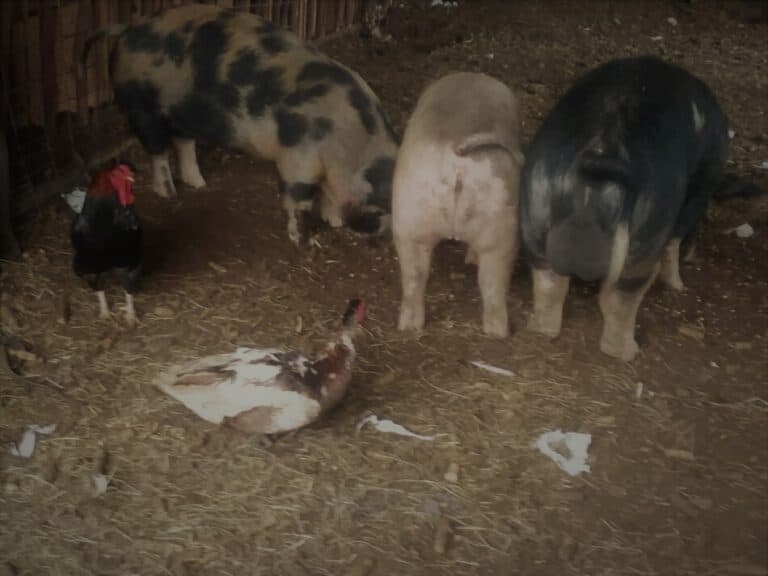Livestock Watering Needs: Plus Extreme Weather Watering Tips

Your livestock will need access to plenty of water everyday of the year.
Some animals can get most of their daily water needs from grass, but still need to drink some water as well. This is especially true for lactating (milking) moms.
Livestock need plentiful, clean water in all seasons of the year. The highest water needs per day will be in the heat and wind.
No matter where you live there are weather related challenges to overcome in order to take the best care of your animals.
Getting them enough water is often one of those challenges.
Of course I’m referring to both extreme heat and extreme cold causing you difficulty watering your stock.
At least here in north central Ohio, we get both weather extremes, so we’ll talk about how to deal with it while taking care of your animals.
Farm Animals That Can Be Raised Together shows you how to keep a variety of animals together and happy.
Water is important to your stock
It can be easy to overlook the importance of water.
We take it for granted instead of viewing water as an essential diet component for livestock as well as ourselves.
Without plentiful water your animals can not grow. It’s that simple.
All of the body processes required for daily living, not to mention growth, need water. Or will be limited or stressed with lack of water.
Water is especially important for an animal getting dry feed or hay.
To digest that dry food the steer/sheep/pig has to take in the water that would come with the food if it we eaten fresh (in order to rehydrate the food).
Your animal will then need more water to use for the digestion process.
Additionally, once your livestock has used the food by extracting all of the available nutrients, the left over parts must be removed from the body.
Obviously we are talking about manure here, but the not so obvious part is this also requires water.
Winter Watering Of Livestock is a University Of Kentucky Master Grazer article that is definitely worth reading.
Can’t my animals get enough water from the grass?
Probably not. It seems likely that they would not need extra water if they are eating all high water forages, but it’s not the case.
Your animals will need less water than if the were eating a dry diet, but they still need water.
Farm or ranch livestock is not selected to perform exclusively in low to no water situations.
Even places that look like there is no water, like the western part of Texas or the cattle stations of Australia, the animals are drinking.
Raising livestock means that the animals are growing.
Growth requires more body processing than just maintenance needs and all body processes require water.
Meaning that a growing/working animal needs more water than a pet or non producing animal of the same species.
Do Sheep Need Water? goes over the times when you’ll need to provide extra water for sheep and the times and situations where they can get enough on their own.
How much water does my herd need?
Any lactating animal will need more water than when it is not lactating.
Dairy animals are going to be the heaviest users of water, needing 50 gallons each per day in the heat.
Beef cattle would come in more like 30 gallons per head per day.
Sheep and goats would need 5-10 gallons per day each.
Sheep and goats will vary the most since they are smaller they can get closer to getting most of their daily water from forages.
The animals all need space at the trough. When the group decides to drink, they all need to be able to get plenty of water in a reasonable amount of time.
Waiting for a hose to slowly trickle water in to one small trough will not cut it here.
Ideal (read fairy tale) situation: You and I both know they could take turns and come up to the water a few at a time.
This would eliminate the crowding at the water trough.
Also, it would be easier to provide all the animals the water they need for the day, since the heavy drinking times would be spread out over the day.
Logical, but not reality. This is not how a herd works.
For the herd, they all do the same thing at the same time.
Since you are providing for your animals, you need to have water available as they need it, on their schedule.
Slow refill times will cause pushing and shoving at the water source. This will result in animals getting unduly stressed at the very least.
More likely is that one will end up getting pushed through the fence, if you are using electric, and now they all are out.
How Much Water Do Cows Drink? is a short article from The University Of Nebraska-Lincoln Beef giving some easy ways to figure up the amount of water your animals need.
Hot weather watering tips for livestock
First thing here is to have the water with the livestock before it starts to warm up for the day.
Ideally, first thing in the morning have plenty of water available to your animals.
It is imperative that you have more than enough water for your livestock in place before the heat of the day.
When it’s crazy hot outside, going out into the pasture or pen to give them water in the heat of the day will cause them stress at the worst possible time.
Plan ahead so you can stay out of the pasture in the heat! Animals that get stressed in the heat die of heatstroke.
A second thing to keep in mind is trough space. Once the animals decide to get up and drink there needs to be plenty of space for all of them to fit.
Pushing and shoving in the heat multiplies the stress of an already stressful day.
It may seem contrary to some of the points above, but keep the float completely out of the reach of your livestock if you are using a float that sits on top of the water.
This may mean limiting access to part of the water trough.
Why? In their pushing and shoving, or just poking around, your livestock will knock the float out of position, maybe even out of the trough all together!
This means you will be watering the ground, not your animals! When it is crazy hot, running on the ground instead of into the trough is a big deal.
Keep them away from the float.
Sub Zero watering tips for livestock
The opposite side of watering problems is with temperatures that fall below freezing. Staying at or just below freezing won’t be a big deal.
Water holds heat it gathered during the day and gives off heat through the night, this is why you see ponds with fog, they are giving off heat to the cold air resulting in fog.
Barely getting into freezing temperatures will not cause you much watering problems.
Most waterers for your animals will be ok at the first frost of the year, but not much more than that.
Where things get dicey is in the periods of extended cold. This is when things start to break and watering your stock becomes much more of a challenge.
Cold weather watering of small animals
For small animals that don’t need a lot of water, consider using a rubber pan that you refill twice a day.
If you get a buildup of ice in the pan, just whack the pan on the ground to break out the ice. I love these pans specifically for this reason.
You could also go with the water pan (or bucket) rotation method. By this I mean have two pans to water your animals in, but use them one at a time.
Take the frozen one in to a warmer room to melt the ice, while you use the second pan to water the stock.
We just got a heated waterer base than we will be trying for the chickens this year, since freezing poultry waterers will break them.
I have also read that people use bird bath heaters in the chicken water pan but I have never done this myself.
Cold weather watering for large animals
For larger animals you are going to need a heated automatic waterer. There really is no other easy option.
Unless of course, you have continuously running water the animals have access to, like a stream fed trough or artisan well, then you are set!
A caution regarding heated automatic waterers
Please be aware that an automatic waterer that is heated can be putting an electrical current through the water, especially if you have an older model.
Look at your animals every day to see that they are relaxed and calmly drinking. If you have not seen them drink you need to make sure the waterer is working.
Using a water trough despite the cold
You can just fill a trough and deal with the ice as best you can.
This is normally our method for the small group of animals we keep inside at various times during the winter.
Be aware that extended cold snaps will reduce the amount of water in the trough as the sides freeze in towards the middle.
In our case, most of the animals have access to water on pasture throughout the winter so they are watering themselves.
This is why a few animals being more difficult to water is not a big deal-it’s just a few.
If it was the whole flock (we have over 300 sheep) that would be a different story!
Don’t overlook the importance of ease of watering in the winter.
Dragging hoses to the house to thaw them out, then dragging them back to start the hydrant is not fun.
It makes a normal chore take forever and be very frustrating.
Keep your hose from freezing
Incidentally, the best way to keep your hose from freezing is to put it on a slope (or raise it in the air) to run out the extra water still in the hose, then blow through the end.
Don’t leave this part out! I know that just putting the hose on a slope should have all of the water out but for us it doesn’t do the job.
If we don’t blow in the end of the hose we have to haul that hose to the basement to thaw and try watering again in a few hours.
At first it will be harder, there will be resistance to the air easily going all the way through the hose.
This is when your air is pushing out the last of the water.
When it gets easy to blow through the hose there is very little water left in the hose and the hose should be safe to leave out until needed again.
How to thaw out a bucket full of frozen water
The easiest thing to do here is to turn the bucket over and pour water on the bottom of the bucket.
Warm water is good but even straight from the tap will help.
The frozen bucket shaped ice cube will pop out and you can use the bucket again quickly.
The reason this works is that all you are thawing out is the small layer of ice holding the chunk of used to be water in the bucket.
You don’t need to wait for all the ice to melt, just the thin outer layer.
The down side here is you end up with quite a few “ice sculptures” around your barn. But, for me, that’s better than no usable buckets!
You can pour warm water into the top of the bucket and wait or leave a hose dripping onto the ice in the bucket and the ice chunk will eventually thaw enough to at least float out.
Either of these methods will work, they just take longer than turning the bucket upside down.





